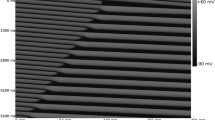Abstract
Reentry in the heart is the repeated excitation of the same tissue by a single excitation wave; it is responsible for several types of cardiac arrhythmia. The simplest model which permits the phenomenon of reentry is two laterally coupled excitable fibers; in this paper we examine such a model in order to establish a basis for the understanding of the fundamental physical processes underlying the process of reentry. Two versions of the FitzHugh-Nagumo equations are used to develop complementary numerical and analytical results for the coupled fiber model. On the basis of numerical studies, regions of qualitatively different behaviour are mapped in the parameter space of excitation threshold and coupling strength between the fibers, and the effect of the rate of recovery is explored. Some of these regions are also obtained analytically, in good agreement with the numerical results. Finally, the results are discussed in the light of recent work on the role of the anisotropy of cardiac tissue in the initiation of reentrant activity in the heart.
Similar content being viewed by others
Literature
Clerc, L. 1976. Directional differences in impulse spread in trabecular muscle from mammalian heart.J. Physiol.,255, 335–346.
Dillon, S. M., M. A. Allesie, P. C. Ursell and A. L. Wit. 1988. Influences of anisotropic tissue structure on reentrant circuits in the epicardial border zone of subacute canine infarcts.Circ. Res. 63, 182–206.
Eilbeck, J. C., S. D. Luzader and A. C. Scott. 1981. Pulse, evolution on coupled nerve fibers.Bull. Math. Biol. 43, 389–400.
Ermakova, E. A., A. M. Pertsov and E. E. Shnol. 1989. On the interaction of vortices in two dimensional active media.Physica D. 40, 185–195.
FitzHugh, R. 1959. Thresholds and plateaus in the Hodgkin Huxley nerve equations.J. Gen. Physiol. 43, 867–896.
Holden, A. V, M. Markus and H. G. Othmer (editors). 1991. Nonlinear wave processes in excitable media.NATO ASI series B 244, 525 pp.
Hramov, R. N., A. N. Rudenko, A. V. Panfilov and V. I. Krinskii. 1984. Vortex drift in two coupled excitable fibers.Studia Biophysica 102, 69–74.
Janse, M. T. and F. J. L. Van Capelle. 1982. Electrotonic interactions across an inexcitable region as a cause of ectopic activity in acute regional myocardial ischemia. A study in intact porcine and canine hearts and computer models.Circ. Res. 50, 527–537.
Janse, M. T. and A. L. Wit. 1989. Electrophysiological mechanisms of ventricular arrhythmias resulting from myocardial ischemia and infarction.Physiol. Rev. 69, 1049–1169.
Keener, J. P. 1988a. A mathematical model for the vulnerable phase in myocardium.Math. Biosci. 90, 3–18.
Keener, J. P. 1988b. On the formation of circulating patterns of excitation in anisotropic excitable media.J. math. Biol. 26, 41–56.
Keener, J. P. 1989. Frequency dependent decoupling of parallel excitable fibers.SIAM J. Appl. Math. 49, 210–230.
Luzader, S. D. 1979. Neurophysics of parallel nerve fibers. PhD Thesis, University of Wisconsin, Madison, U.S.A.
Luzader, S. D. and A. C. Scott. 1984. Interactions between propagating action potentials. InThe Neurobiology of Pain, A. V. Holden and W. Winlow (Eds), pp. 121–134. Manchester: Manchester University Press.
McKean, H. P. 1970. Nagumo's equation,Adv. Math. 4, 209–223.
Markin, V. S. 1970. Electrical interactions of parallel non-myelinated nerve fibers. 1. Change in excitability of the adjacent fiber.Biophysics 15, 133–155.
Nandapurkar, P. J. and A. T. Winfree. 1989. Dynamical stability of twisted scroll rings in excitable media.Physica D 35, 277–288.
Panfilov, A. V. and A. V. Holden. 1990. Vortices in a system of two coupled excitable fibers.Phys. Letts A. 147, 463–466.
Rinzel, J. and J. B. Keller. 1973. Travelling wave solutions of a nerve conduction equation.Biophys. J. 13, 1313–1337.
Sasynuik, B. I., C. Mendez. 1971. A mechanism for reentry in canine ventricular tissue.Circ. Res. 28, 3–15.
Schmitt, F. O. and J. Erlanger. 1928. Directional differences in the conductance of the impulse through heart muscle and their possible relations to extrasystolic and fibrillatory contractions.Am. J. Physiol. 87, 326–347.
Spach, M. S., W. T. Miller, B. B. Geselowitz, R. C. Barr, J. M. Kootsey and E. A. Johnson. 1981. The discontinuous nature of propagation in normal canine cardiac muscle.Circ. Res. 48, 39–54.
Winfree A. T. 1987.When Time Breaks Down. Princeton, NJ: Princeton University Press.
Wit, A. L., P. F. Cranefield and B. F. Hoffman. 1972. Slow conduction and reentry in the ventricular conducting system. II. Single and sustained circus novements in networks of canine and bovine Purkinje fibers.Circ. Res. 30, 11–22.
Author information
Authors and Affiliations
Rights and permissions
About this article
Cite this article
Palmer, A., Brindley, J. & Holden, A.V. Initiation and stability of reentry in two coupled excitable fibers. Bltn Mathcal Biology 54, 1039–1056 (1992). https://doi.org/10.1007/BF02460665
Received:
Revised:
Issue Date:
DOI: https://doi.org/10.1007/BF02460665




